2025-12-18 21:42:32
This year hit me like a bulldozer. There was no amount of reading and research that could have prepared me for this level of intensity, and I want to start this annual review by saying thank you.
I’m grateful to my body and brain for mostly holding up. I’m grateful I have access to spaces and tools such as psychedelic medicine, ecstatic dance, and entrepreneur retreats that have helped support my mental health throughout this journey.
Most of all, I’m grateful to the people in my life – my family, friends, colleagues, and the entire Ness Labs community – who all showed up in wonderful ways this year.
So much happened, but here’s a quick bullet-point overview before I dive in:
I consider myself a child of the internet. As a teenager, I had a hand-coded blog and a community of online friends from all over the world, whom I’d only ever communicated with in writing via phpBB forums and our ‘blogring’ (remember those?).
Although I had a bunch of odd jobs when I was younger, my first ‘real’ job was at Google, and Ness Labs is largely an online business – with an online newsletter, online community, and online courses.
So I thought I was prepared for the influx of online attention I’d get when launching the book. Boy, was I wrong.
Going on dozens of podcasts was not only exhausting at times, but getting featured on big YouTube channels meant millions of people heard from me for the first time – and not all of them were nice. When the book came out in March, I really struggled with the rare but still hurtful comments on my accent, my appearance, and my supposed unchecked privilege.
I didn’t have to deal with Tim Ferriss levels of threats, but to give you an idea, some commenters said my accent made their ears bleed, that I must be funded by my parents, and that I should go back to my country. I knew I shouldn’t care, but I did, and it took a couple of months to build a digital immune system.
In general, my physical and mental health wasn’t great during the launch. Being in the US meant I didn’t have my healthy routines, including my favorite snacks, familiar local walks, and coffee catch-ups with close friends. I did go to ecstatic dance a couple of times in New York and Austin, but it wasn’t the same as having my regular practice in London.
All the traveling also meant I cancelled meaningful annual rituals. Each year, we organize a psilocybin ceremony with my best friends; that didn’t happen (but I did get to organize one for my family). I spent part of my teenage years with a foster family and normally visit my second mom once a year; that also didn’t happen.
I gained weight, my sleep was all over the place, and I even skipped many days of daily journaling – something I hadn’t done in years.
Part of me felt guilty about promoting a book that includes an entire chapter on mindful productivity when clearly I still had lots to learn myself. But I was also incredibly grateful for the tools and mindset I’d developed that kept me from completely burning out, even if this pace wasn’t sustainable long-term.
Then, in July, when I had planned to take a much-needed break, I discovered that the French translation of Tiny Experiments was so bad that I couldn’t bear the idea of putting my name on it. So I ended up spending the entire month translating my own book into French. This didn’t help with my mental health, but it gave me deep appreciation for the craft of a translator.
Fortunately, just when you’re stuck in a rut, life has a way of jolting you awake – even if it’s not how you’d choose to be woken up.
This year, my mom turned 70, and for her birthday she asked that we all go back to Burning Man as a family so they could renew their wedding vows. This was a magical week. Not just the serendipitous encounters, the heart-opening conversations, the art and the music, but having my phone off for an entire week, with no sense of time, waking up and going to bed when my body wanted to, eating when I was hungry and not as a way to cope with stress, and walking, cycling, dancing every day – it healed me deeply.
That is, until the last day, when my dad collapsed in my arms and had to be rushed via helicopter to the hospital in Reno, where he was unconscious for the longest 48 hours of my life.
I wrote about it elsewhere so I won’t repeat it here, but this terrifying experience had the effect of reconnecting me with what truly matters: to share the precious little time we have on this earth with the people we love, to connect with other human beings on this messy journey that is life, and to be as present as possible for each of those beautiful, challenging, magical moments.
The second half of the year was a slow process of rebuilding, reprioritizing, recentering. I decided to let go of two members of the extended Ness Labs team and to invest more in the growth of core team members. We agreed on shared mental models to drive our day-to-day business decisions and built new systems to support these.
In the spirit of learning in public, I also decided to publicly embrace the messiness of the process, letting go of my fear that people wouldn’t trust my expertise if I looked like I was still figuring it out.
When I froze on stage during my TEDx talk in front of 800 people, I decided to share that experience instead of hiding it in shame. The post went somewhat viral and resulted in many new people discovering my work. I also shared screenshots of some of the rude comments and emails I received instead of processing them on my own.
I think this vulnerability played a big part in the growth of the Ness Labs community this year by attracting like-minded people who want to live more openly, honestly, and kindheartedly. Tiny Experiments sold more than 60,000 copies in its first six months, and my Instagram account grew from 3,000 to more than 50,000 followers in the past twelve months.
And ultimately, the kind and constructive messages from people of all ages and backgrounds around the world vastly outnumbered the hurtful ones.
I write an annual review every single year because looking back helps me move forward. Reflecting on 2025, I see several themes I’d like to keep exploring and trends I’d like to shift.
Professional life – I couldn’t have hoped for more success in this area, but a lot of it was built on sheer effort and willpower, which aren’t sustainable. Moving forward, I’d like to keep building systems with my team and say no more often so I can focus on the projects that can truly have a meaningful impact.
Intellectual life – While I did manage to produce research, my academic work felt very output-oriented: data collection tasks, grant proposals, ethics applications. In 2026, I want more space for reading and thinking. I know how it might sound after the year I’ve had, but I’m also starting to outline my next book, which shows me that I truly love writing (or that I might be a bit crazy, or both).
Spiritual and personal life – Rituals and time in community are crucial to maintaining my physical and mental health. I want to build my life around those foundations, with work fitting around them rather than the other way around.
Lastly, this year made me even more grateful for the amazing people in my life. I’ve been terrible at staying in touch – my WhatsApp is an absolute mess and I’ve been slow to respond or completely missing messages. Thankfully, my friends are wonderful and nobody resented me for not being a great friend this year. If you’re someone I haven’t replied to, please follow up with me; that would be the best holiday gift 
Thank you for reading, and happy new year!
The post 2025 Year in Review: Presence versus Performance appeared first on Ness Labs.
2025-11-20 19:39:44
Welcome to this edition of our Tools for Thought series, where we interview founders on a mission to help us think better and work smarter. Gregorio Zanon is the founder of Popt, a mobile notes app built for seamlessly connecting ideas, contacts, places and time.
In this interview, we discussed the nature of mobile note-taking, developing a product culture of digital privacy, why it makes sense to navigate our notes as an interconnected map, and much more. Enjoy the read!
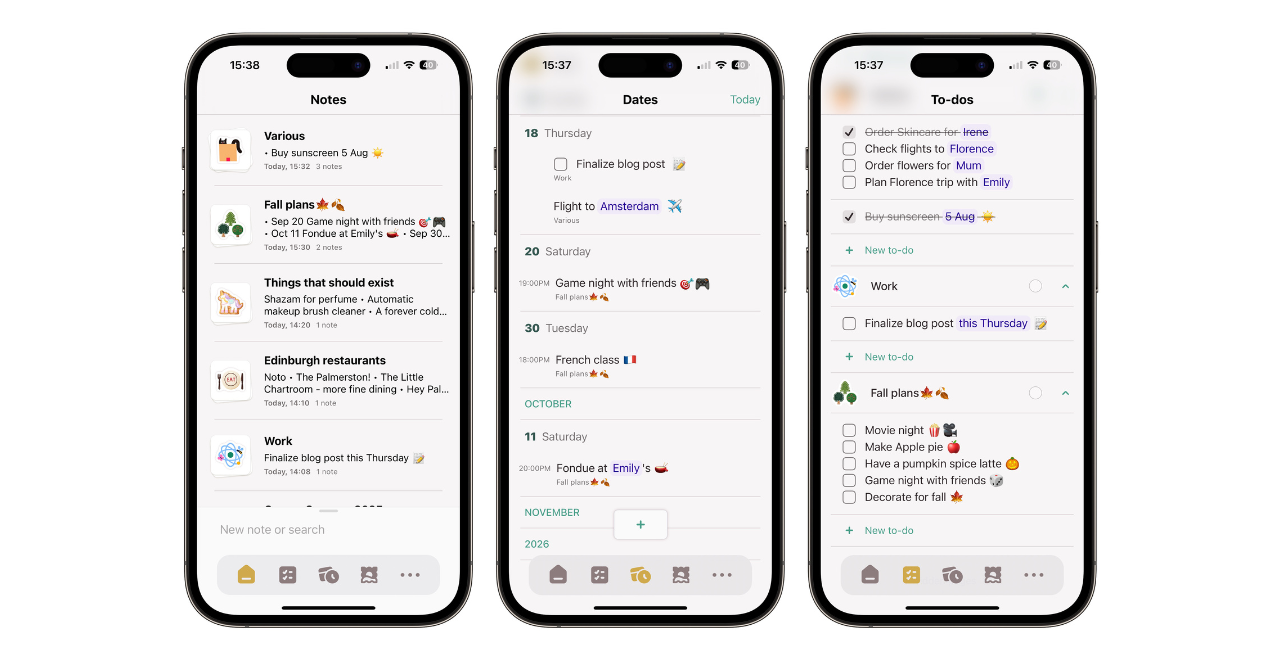
Hi Gregorio, thank you for joining us. You built Popt around the idea that note-taking should be quick, private, and intuitive. Can you tell us about the moment you realized there was room for something different?
Mobile note-taking is very much its own thing – it’s not about sitting down to write an essay or organize a knowledge base. It’s about capturing thoughts in motion. Say you’re in a conversation, or walking out of a meeting, or halfway through a film, you don’t want an app that makes you think about structure and hierarchies. You just want to jot something down.
At the same time, our smartphones pack an insane amount of power, so why not leverage that and enhance how useful mobile notes can be?
With Popt, we want to bring the depth of networked note-taking to mobile, without slowing you down. Instead of hashtags or manual links, you link real-world objects as you type: people, places, dates, movies… Those tags add extra dimensions to your notes, turning them into reminders, contact cards, maps and collections – all without ever forcing structure on you.
We also made a deliberate choice not to rely on cloud-based LLMs such as ChatGPT. Your notes should be a safe space. You shouldn’t have to wonder where they’re going or who could read them. Sending them to an opaque server would be slow, waste resources, and compromise your privacy. So we built our own text analysis pipeline that runs entirely on-device. It’s not an AI, but a human-designed layer of tagging suggestions that helps you connect things together without interrupting your flow.
You’ve said that note-taking should “work the way your mind works.” How did that shape the way you’ve approached design and development?
Let’s slightly rephrase for emphasis: “Note taking should work the way your mind works.” Now, of course we don’t know how your mind works.
So we try to do the next best thing – to support diverse note taking flows. For example, you can use the notepad at the bottom of the screen as a scrapbook to jot down a quick shopping list. Or to start a new page. Or add a note to an existing page. You can name pages and pick cute stickers to make them stand out. But you can also entirely ignore pages and just have a list of plain notes, à la Apple Notes.
You can accept a tagging suggestion as you type, or keep going – the suggestion will simply disappear, until you move the cursor back to where it made sense. You can set a reminder for a day (without setting a time). Or for a week (without picking a day). Or for next year. And be more precise later – or leave it fuzzy.
Popt strives to stay out of your way and let you do your thing, in whatever order you see fit. You don’t have to tag / name / choose / organise, but you can if you choose to.
Let’s talk about how Popt works. A core feature is that it automatically recognizes people, places, and dates as you type, turning plain text into an interconnected map of your life.
Instead of manual tags, Popt offers to link your words to the real world, which is more human and much less taxing for your brain than having to think about a tagging scheme. It sounds pretty abstract so I’ll give an example – let’s say I’m planning a trip to Paris in December.
Because I’m a foodie, the first thing I want to do is book lunch at my favourite vietnamese joint there. I open Popt and write in the notepad: “Lunch with Flavia at mam from hanoi dec 11 1pm.”
As I type, I accept Popt’s tagging suggestions for my sister Flavia, the restaurant Mam from Hanoï, and the date. Here’s what the note looks like when I’m done:
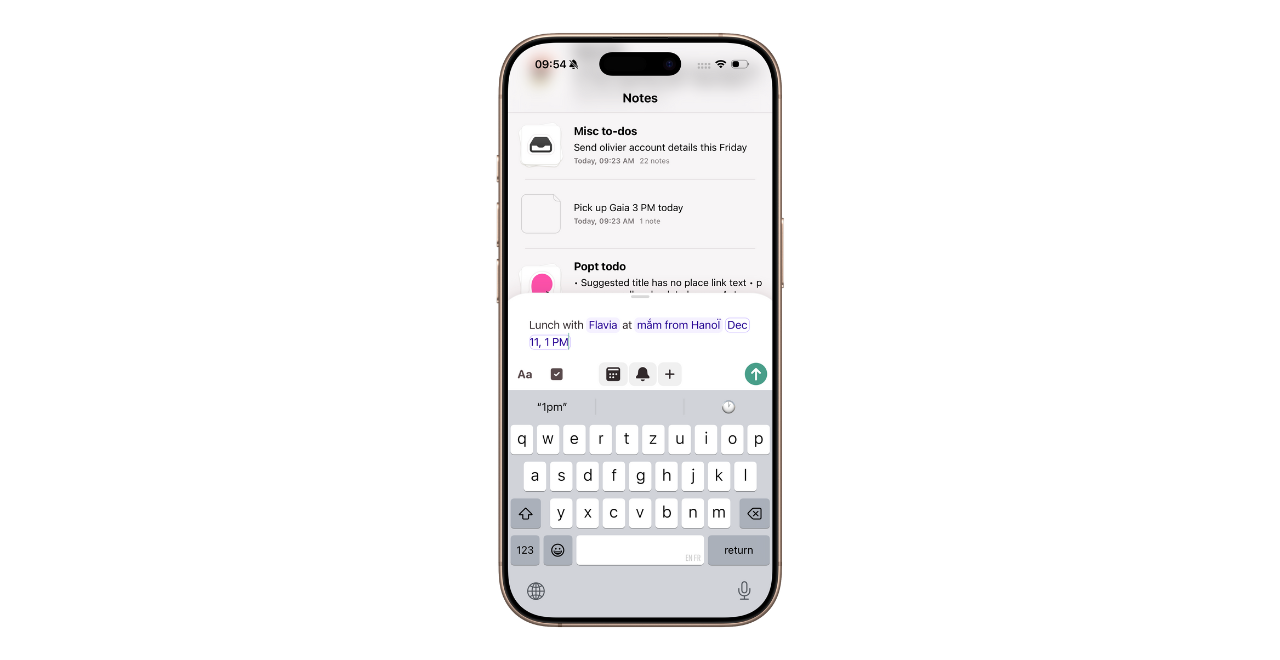
I press the bell icon to set a reminder, and submit the note just like you’d send a message. I’ll return to it later to add more trip planning items.
A few weeks pass and I’m finally having that delicious noodle soup with my sister. As we chat, she recommends a movie, Arco. I easily locate the note about our meeting, through the Dates tab (it’s just there under Today), and add the movie thanks to our integration with The Movie Database:
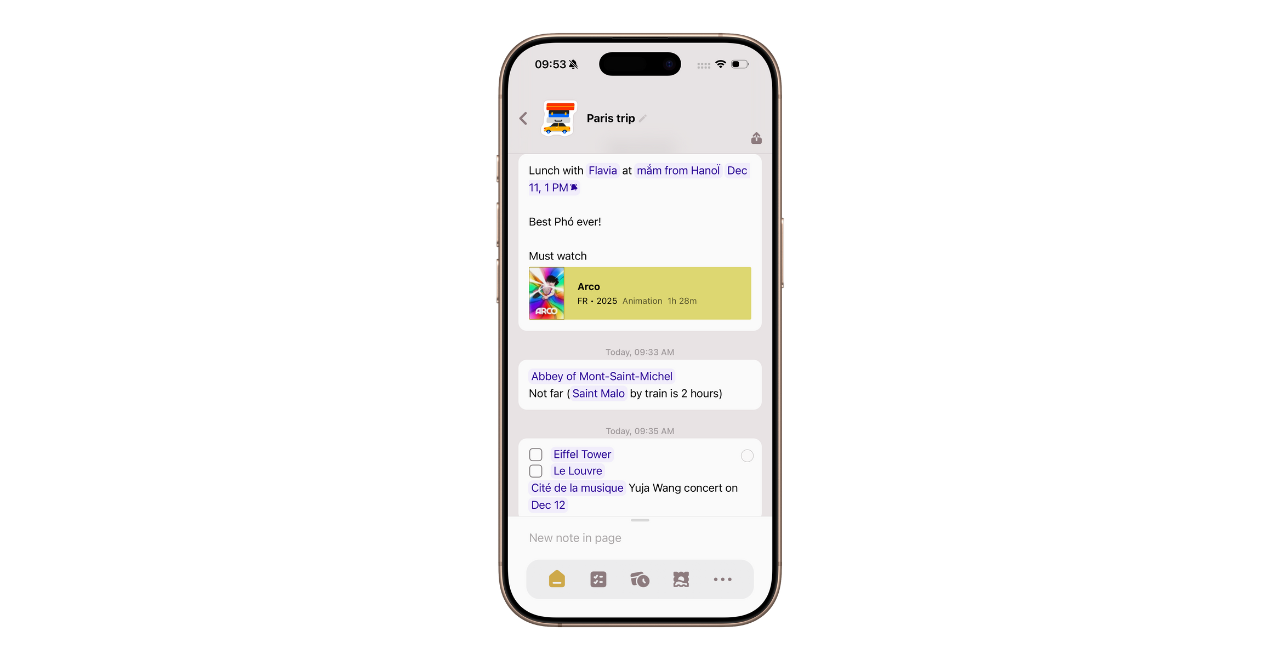
You can see that I turned the initial note into a page named Paris trip, and added a few more notes to that page. I can quickly insert a comment about the food, and the movie suggestion, which becomes a widget.
In just a few words, I’ve linked together a moment in time, a place, a contact and a movie. Places show up in a dedicated tab, reminders and dates on an agenda-like timeline, and movies in their own collection:
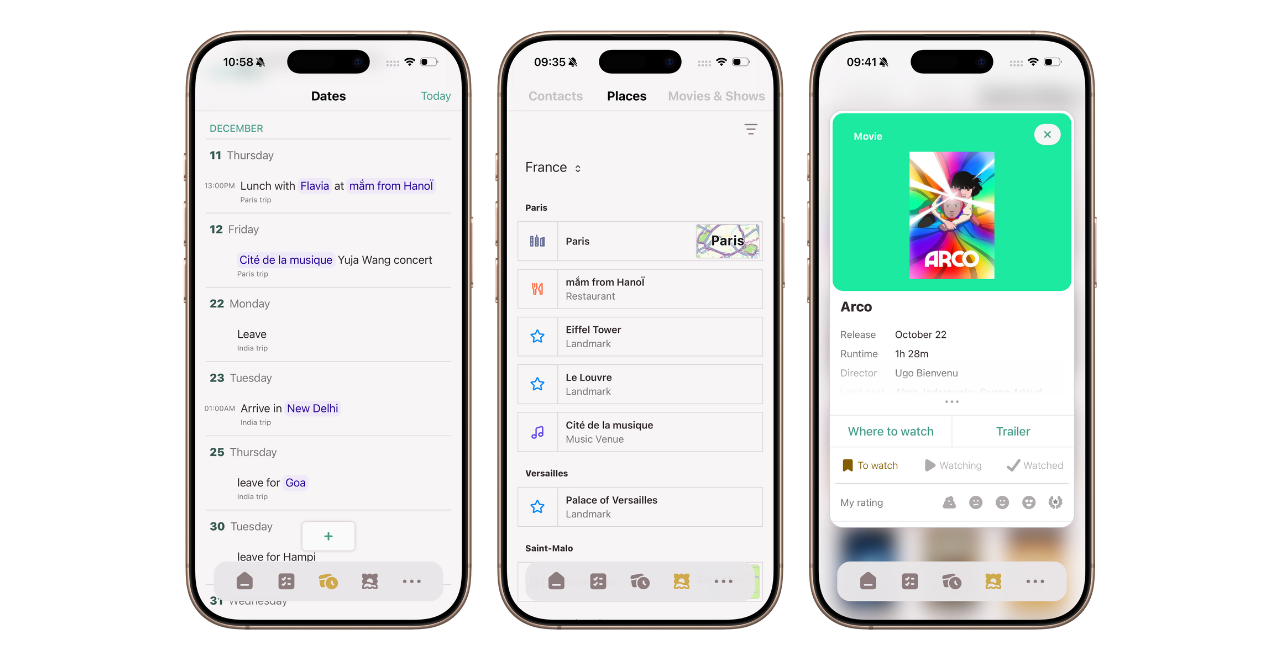
I can get directions to the restaurant, watch the trailer for the movie, and call my sister to let her know I loved it, all from the same note. Not bad!
You often talk about your deep respect for privacy, and everything happens on-device. Why was that so important to you?
We’re based in Switzerland, a country where privacy is very much part of the culture. But even beyond that, would you feel comfortable taking notes knowing that the thoughts you commit to your phone can be read and analysed by third parties? We think it’s 100% worth the extra hassle to make sure that Popt can work fully offline and that your words are yours only.
For now, Popt doesn’t sync to any cloud so the problem remains relatively simple – the notes just don’t leave your phone. And when Popt needs to connect to an external service, like The Movie Database or Apple Maps, we never send text from your notes to those services – instead, we show you a search box that’s clearly clearly labelled to make sure you’re aware that what you type there isn’t 100% private anymore.
On the flip side of the privacy coin is data ownership. You own your notes and can export them in bulk as plain text files. Our export format is also compatible with Obsidian, so that if for any reason you want out, you can always export them to another app or device and browse your Popt content without requiring paid software.
What about you, how do you use Popt?
I personally use Popt multiple times a day. The most common notes are quick to-dos and reminders, but I also plan trips, list movies and grow a collection of my favourite foodie joints. Then, I should mention that I document Popt bugs in Popt – whenever I notice something that doesn’t work as it should, I add that to my Popt Bugs page, which is very meta… I’ll let you guess the sticker I chose for that one.
Finally, a good use case for the sharing feature came up very recently. My wife and I were both extremely busy last week so her dad stayed with us and helped with the kids. We made a Popt page for him, containing a daily schedule for school hours, music and swimming lessons, and the birthday party one of them was invited to.
The page also included tags for places and contacts, so it was super easy for my father-in-law to get directions, call a parent or teacher if needed, and even add reminders to any of the numerous items on schedule. Definitely a proud moment 
And finally… Looking ahead, what’s next for Popt?
We soft launched Popt barely 2 months ago and still think of it very much as our baby app. Of course, we’d love to add more refined suggestions, more tag types (books, games, music), more sharing options, more platforms… but as a small team we have to take things one at a time and prioritise features which our users need the most.
It’s super easy to give Popt a whirl and send feedback our way – no sign up and no paywall, just Popt. We hope your readers will give it a go!l
Thank you so much for your time, Gregorio! Where can people learn more about Popt?
Thank you! You can visit our website, blog, and follow our updates on LinkedIn, Instagram, and TikTok.
The post Tap into smarter notes with Gregorio Zanon, founder of Popt appeared first on Ness Labs.
2025-11-20 19:21:57
I still remember an assignment where our history teacher asked us to create an ‘artifact’ about a historical figure of our choice. I chose Jesus and spent hours at the school library, asking the librarian for every book that mentioned him, and made a mini book with hand-drawn illustrations.
I was completely absorbed in the process and it remains one of my favorite school projects. (although I did a terrible job separating historical fact from later additions and got a bad grade!)
Around the same time, I also remember sitting in my bedroom for hours trying to solve math equations, hating every second of it.
Same brain, same time investment, completely different experience.
Why do we sometimes love learning while other times we can’t wait to escape and something else? How does this affect how well we actually learn? And what can we do about it?
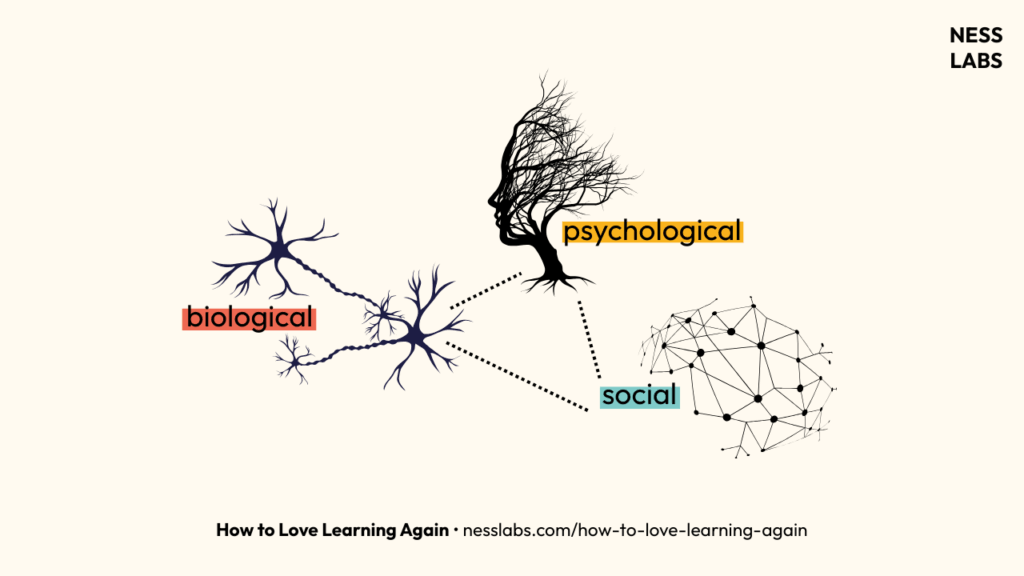
When we’re genuinely curious about something, our brains release dopamine – the same neurotransmitter involved in other rewarding experiences. This creates a positive cycle: curiosity leads to exploration, which leads to discovery, which triggers more dopamine and makes us want to keep going.
But this system only works when we feel safe to explore. When learning feels threatening – i.e. when we’re worried about failing or being judged – our brains shift into survival mode.
The prefrontal cortex, responsible for complex thinking, becomes less effective under stress. That math problem stops being a puzzle to solve and becomes something to endure.
The ingredient that transforms learning from threat to opportunity is agency: when we have confidence and some autonomy over what we learn and how we learn it, and understand why we’re learning it.
But what shapes our sense of agency in the first place? Understanding this can help us create better conditions for loving learning. Three key forces influence our learning experience:
When your biology, your psychology, and your social environment align positively, learning becomes more fun. You retain information better, think more creatively, and persist through challenges. But when they work against you, you tend toward surface-level processing and giving up quickly.
And these patterns compound over time! Early positive experiences build confidence, while negative experiences can create the opposite trajectory, leading to avoidance and deepening this belief that you don’t like learning.
Your relationship with learning isn’t fixed. Neural plasticity research shows we can rewire how we respond to learning. The key is starting small and building positive momentum. Here are five practical steps you can try:
1. Decouple the topic. Recognize that hating math doesn’t mean you hate learning – you might just hate how you’ve been taught math. Focus on how you’re learning, not just what you’re learning.
2. Run tiny experiments. Try different approaches to discover what works for you: visual diagrams, talking through problems aloud, or working with others. Mix up your environment, timings and methods.
3. Practice metacognition. Pay attention to how you feel. Track what energizes you and what drains you. Notice when you feel engaged or bored. Identify your optimal learning zone – not so easy that you’re bored but not so hard that you’re overwhelmed.
4. Learn with others. Find a learning community, a study group, or opportunities to teach others. Share your struggles, ask questions and celebrate discoveries together, including what you learn about yourself.
5. Focus on growth. This is about embracing mistakes as data, focusing on what you learned rather than how you performed. An easy way to focus on growth is to track your progress with the PACT framework instead of measuring your success with SMART goals.
Your relationship with learning is shaped by biological, psychological, and social factors that you can influence. Just choose one tiny learning experiment to try this week, notice how it feels, and adjust as you go.
By understanding what makes learning feel good and experimenting with different approaches, you can rebuild a positive relationship with learning.
The post How to Love Learning Again appeared first on Ness Labs.
2025-11-04 17:33:00
We’ve all felt that familiar knot in our stomach when facing the possibility of failure. It’s the subject of countless articles, TED talks and self-help books: how to face it, learn from it, bounce back from it. We’ve become experts at preparing for things to go wrong.
But here’s what’s rarely discussed: our complicated relationship with things going right.
What if the project takes off beyond your wildest expectations? What if the funding comes through? What if that promotion you’ve been angling for actually lands on your desk next week?
“What if it works?” is a question that can reveal a lot about your true desires and fears. What changes when you get what you think you want? And more importantly, do you really want those changes?
Research suggests that the brain’s threat detection system reacts not just to danger, but to any kind of unpredictability. That’s why even positive change such as success, recognition, or new opportunities can produce anxiety.
Think about the last time you got unexpectedly good news. Along with the joy, did you feel a flutter of “Oh no, now what?” That’s your brain trying to regain control of an uncertain situation.
When faced with this discomfort, most people instinctively choose one of two paths. Some pull back and avoid the unknown altogether. Others push forward aggressively, trying to dominate the uncertainty through sheer force of will.
Fear of success represents the avoidance mode. Psychologically, it’s driven by loss aversion. Success often requires giving up things we value: comfort, privacy, freedom, predictability, or even a familiar sense of self. These losses can feel more real than the abstract benefits success might bring.
Blind pursuit of success is the opposite reaction: autopilot ambition. We chase success for the security and validation it promises, assuming that more is automatically better, without pausing to examine whether it truly fits the life we want to build. We end up climbing ladders only to discover they’re leaning against the wrong wall.
Both are understandable reactions, but neither is particularly strategic.
But there’s a third option: strategic success. Instead of reacting instinctively to uncertainty, we create space to ask what success would actually mean for our lives and whether those changes align with our deeper values and priorities.
It’s the shift from reaction to reflection, from seeking control to making conscious choices.
If you’re working toward something important right now – whether that’s a career change, a creative project, a business launch, a relationship milestone – try this brief metacognitive exercise:
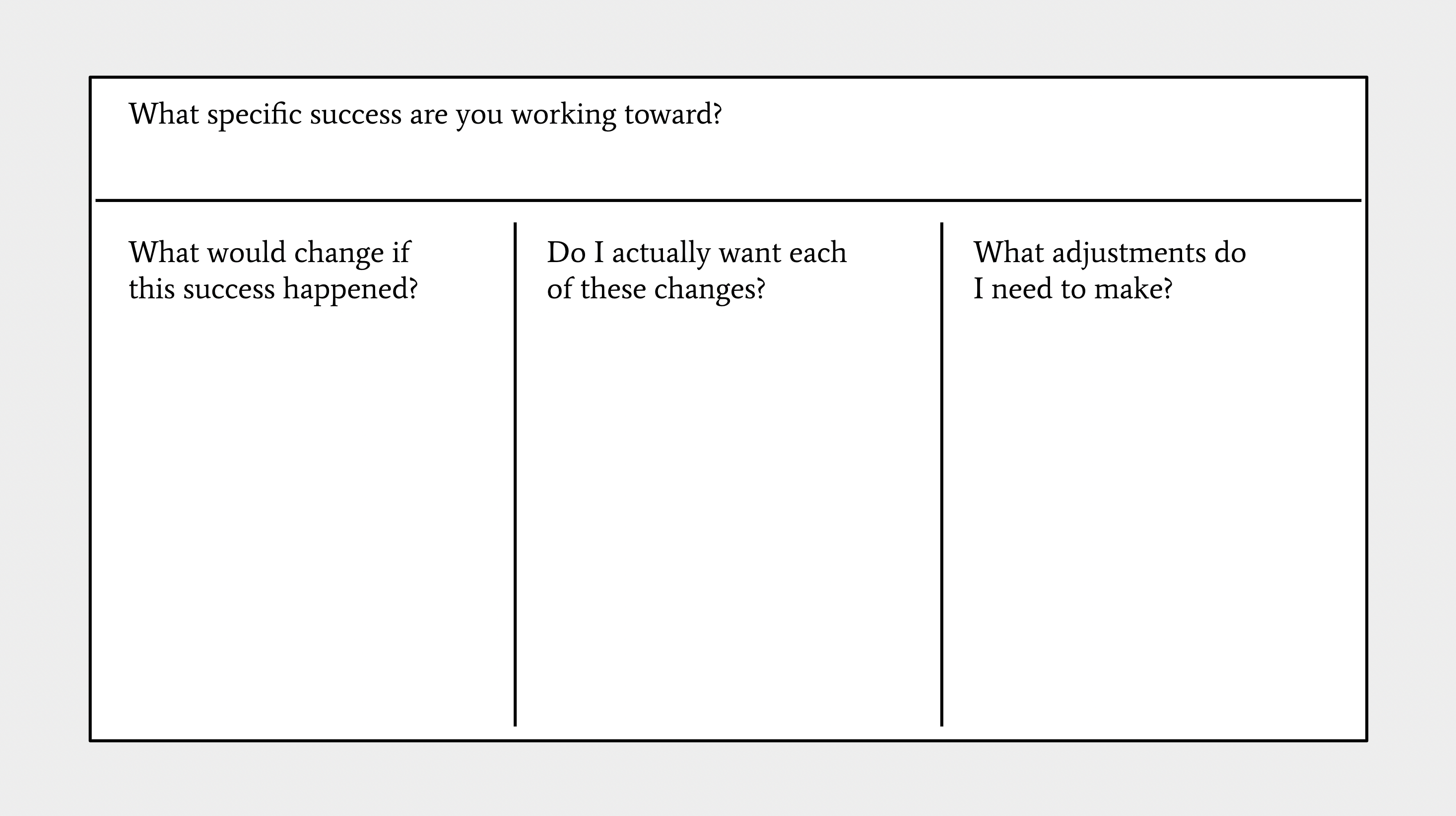
1. Name the success clearly. Write down the specific outcome you’re working toward. Not the vague hope (“things work out”) but the concrete reality (“I land the VP role,” “I get this new client,” “my book gets published,” “we secure series A funding”).
2. List what would change. Consider your daily schedule, energy allocation, relationships, responsibilities, financial situation, social dynamics, and even your identity. If you became known as “the VP” or “the published author” or “the CEO,” how would that feel?
3. Ask “do I actually want that?” Would you welcome the increased visibility, or does the thought make you want to hide? Are you excited about managing a larger team, or does it sound exhausting? Do you want the financial upside enough to accept the pressure that comes with it?
4. Adjust accordingly. If some of the changes don’t appeal to you, treat this as valuable information. You might need to redefine what “success” means for you specifically or build in safeguards to protect what matters most, or even reconsider whether this particular ambition is worth pursuing.
This exercise takes about 20 minutes but it can save you years of pursuing outcomes that look good from the outside but feel wrong from the inside. It ensures that the success you’re building is one you’ll actually want to live with.
When you’ve considered what success would actually mean for your life, you can pursue it with a sense of calm clarity or consciously choose a different path entirely.
Either way, you’re no longer just hoping things work out. You’re actively designing what “working out” means for you.
The post What if it Works Out? The Science of Strategic Success appeared first on Ness Labs.
2025-10-14 14:28:34
Welcome to this edition of our Tools for Thought series, where we interview founders on a mission to help us think better and work smarter. Steffen Bleher and Michael von Hohnhorst are the founders of Capacities, an object-based knowledge management space that allows you to connect your thoughts, get new insights, and use AI in your knowledge work.
In our first interview with them, we explored the inspiration for their work. In this interview, we went deeper and talked about their philosophy of object-based note-taking, how they aim to create a calmer and more human digital workspace, why they focus on individuals rather than teams, their design principles and integrations, their long-term vision for helping people think more intentionally, and much more. Enjoy the read!
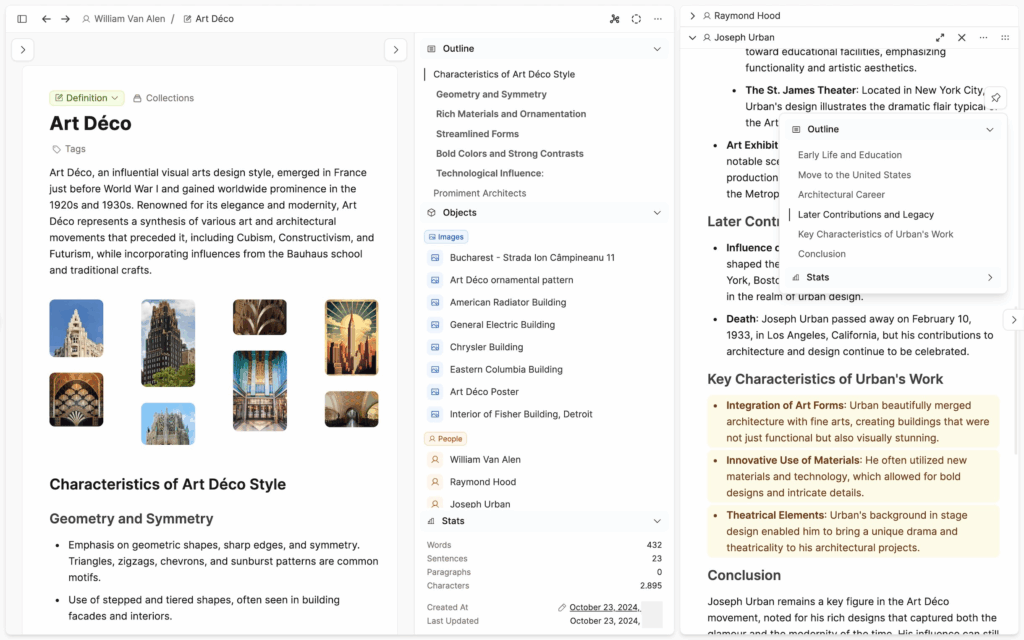
Hi Steffen and Michael, thanks for coming back for another interview! You decided to build Capacities when you noticed how unnatural knowledge work tools felt. Can you tell us more?
We met at university, where we were both studying electrical engineering. Almost nothing in our studies made use of digital tools; it was all pen and paper. Lots of paper! Yet, at the same time, we were taking classes in computer science and learning about all these powerful digital technologies to store and process information.
While pen and paper often work perfectly well, this gap sparked our curiosity, and we started thinking a lot about the best ways to represent knowledge digitally and how to create better tools for knowledge work. Curiosity and passion were our core drivers from the beginning. We did not know the market and landscape of tools that well when we first started thinking about it. But when we did some research and looked at existing solutions, they all tended to focus on hierarchical structures to organize information.
Our insight was that connections between information are equally important, if not more important, especially when you are learning new things. Your brain does not work like a computer, where you create a new folder and put a bunch of new stuff in there. It’s a network that you can expand by connecting new information with existing knowledge. We decided to explore this idea further.
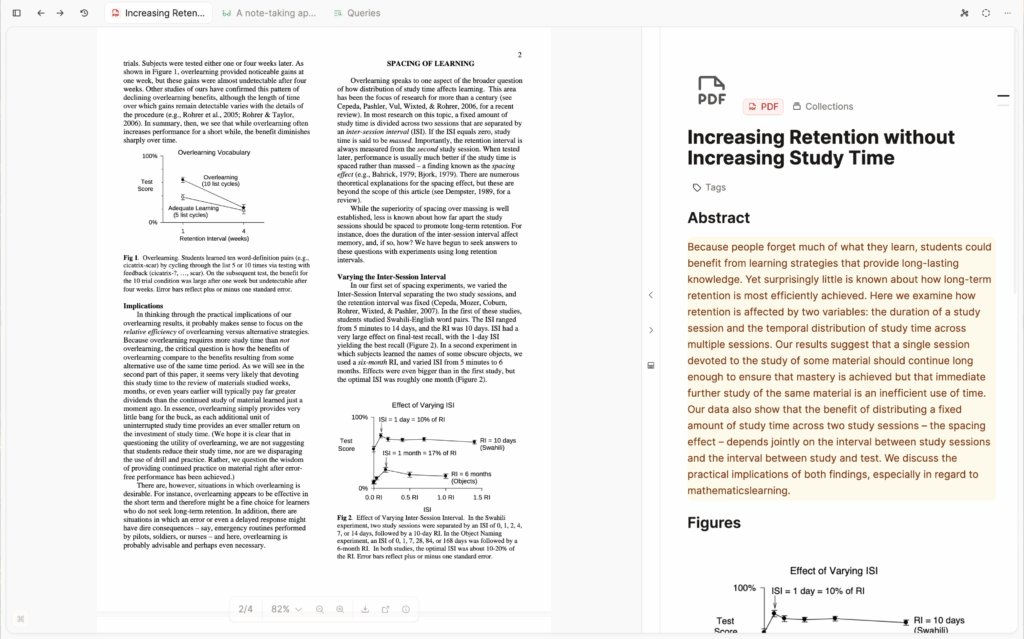
What was your vision at the time, and did it evolve since then?
Originally, we wanted to build a learning and teaching tool for the education sector. But over time, we moved toward a note-taking tool for knowledge workers, mostly because we wanted a direct relationship with our users and a simple business model (educational software tends to involve many different stakeholders, complicated business models, and high compliance requirements from the start, all of which are not very compatible with bootstrapping a business).
Our guiding idea has always been to find better ways to structure information and support learning. And this idea, paired with curiosity, explains a lot of what we do. Another thing that is important to us is to also make something that’s beautiful and easy to use. We don’t want to build software only for very technical people, but software that is accessible to everyone looking for better ways to learn and organize information.
Today, we would describe our mission as this: we’re working on solving information overload for curious, engaged, and passionate individuals to help them do their best work and ultimately, live more intentional lives.
The last part might need some explanation. In today’s digital landscape, we’re bombarded with so much information that it can become difficult to remain focused. We may end up in a situation where our attention and thoughts are controlled solely by external factors.
With Capacities, we want to play a role in flipping this around and empower you to follow your own, intrinsic curiosity, to help you figure out what’s really important to you, what you want to spend your time on, and what you—and not others—think about a given subject.
This is definitely not against the idea of getting external input or meant to be a hyper-individualistic view of only focusing on yourself. It’s about not skipping the step of doing your own self-directed thinking and reflection first, and being more intentional with what you do with the information you choose to consume.
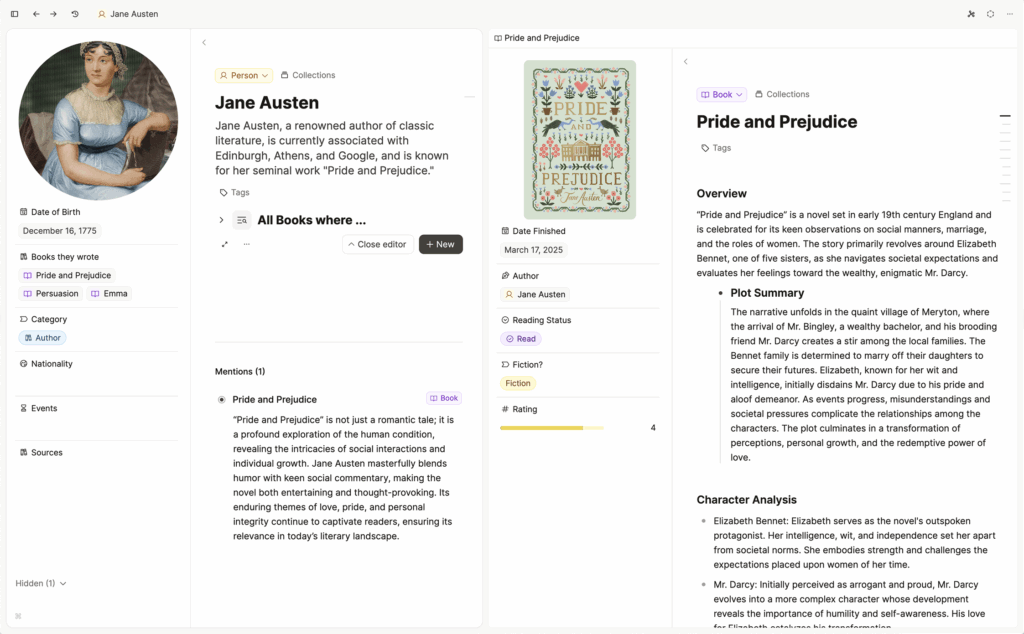
You wrote in your core principles that the individual is in the center of everything you do. What does that mean exactly?
We’re building Capacities for individuals in part because we feel many other apps on the market, especially big players, are built with teams, businesses, and collaborative features at the center of their approach. This is great, but many people are missing an experience designed just for them and their needs.
When we are building Capacities, we’re building it for you. Capacities is a safe and calm place individuals can retreat to in order to do their best thinking. There is no outside noise, nothing pulling at your attention, nothing you need to do other than what you choose to focus on.
Quite frankly, we’d probably have an easier time catering to businesses and selling enterprise licenses, but this isn’t what we want to do. Every individual user matters to us, and we’re unwilling to compromise on the individual experience. Individuals, whether working by themselves or within a larger team, deserve the space to think in peace. This is the experience we’re building for our users.
We truly believe in the importance of having a space that just belongs to you. A space where you can be vulnerable, think, and write freely, and let creativity flow without external filters. The design and functionality of a tool can nurture this kind of thinking—or stifle it before it begins.
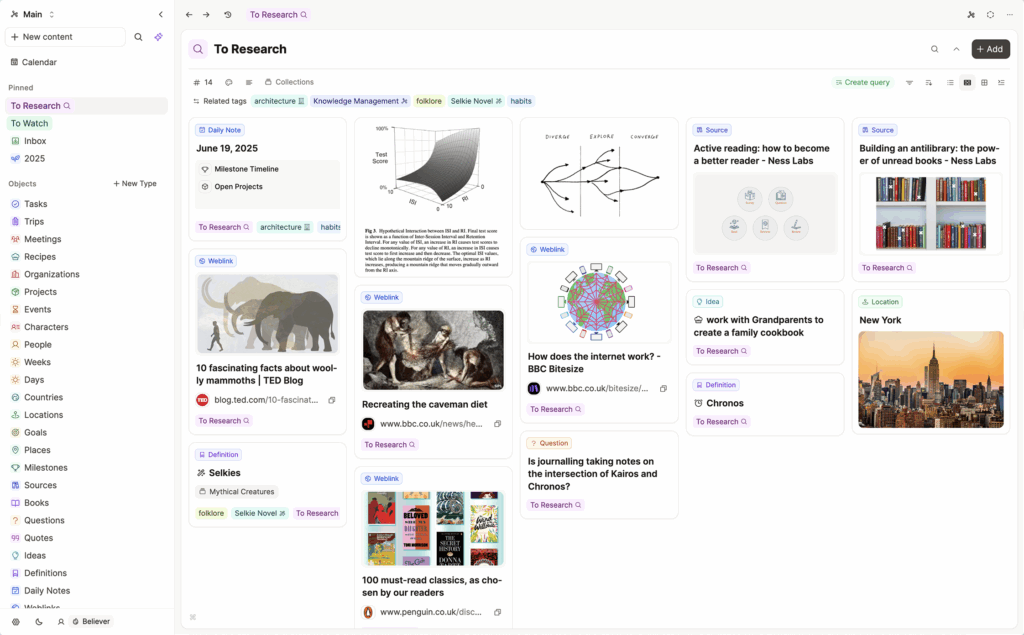
Capacities is built around objects as the unit of thinking. Can you explain why this is central to your approach?
Object-based note-taking is an antidote to the existing culture of software that is structured around the way computers think. People don’t think in files and folders, so why should we structure our information around them as well?
If you think of the world around you and what you interact with, you’re engaging with things: objects. You see people every day, you watch films, you participate in meetings, and you read books. In Capacities, each of these things becomes an object type: People, Films, Meetings, Books.
Maybe a person, let’s say your good friend, Julie, with whom you frequently talk about books you read, recommended a book to you. In your Capacities notes, you’ll be able to connect Julie to the book she recommended and have an easy way to add it to your reading pipeline. In fact, you can represent that information in just one sentence without ever thinking about where to put this information.
On your daily note, which is a go-to place for things you encountered on that day, you simply write the sentence “Julie recommended The Years by Annie Ernaux.” While you write, you simply link to “Julie”, the person, “The Years”, the book, and “Annie Ernaux”, the author, to be another person.
Each of these become objects of that type. They become a “thing” in your system that you can reference in the future and take further notes on. The Julie object contains information about Julie and is a separate entity from the book object, which can include your thoughts on the book. If you visit the page of any of the objects we just created, you will find the sentence in their backlink section, including the date of the daily note you wrote it in—giving you the full context.
Additionally, by nature, books are different to people. Your notes on them should also look different. People have birthdays and favourite foods, and books have authors, genres, ratings, summaries, and blurbs. You could also assign a “status” property to track all books you want to read, are currently reading, or have already read.
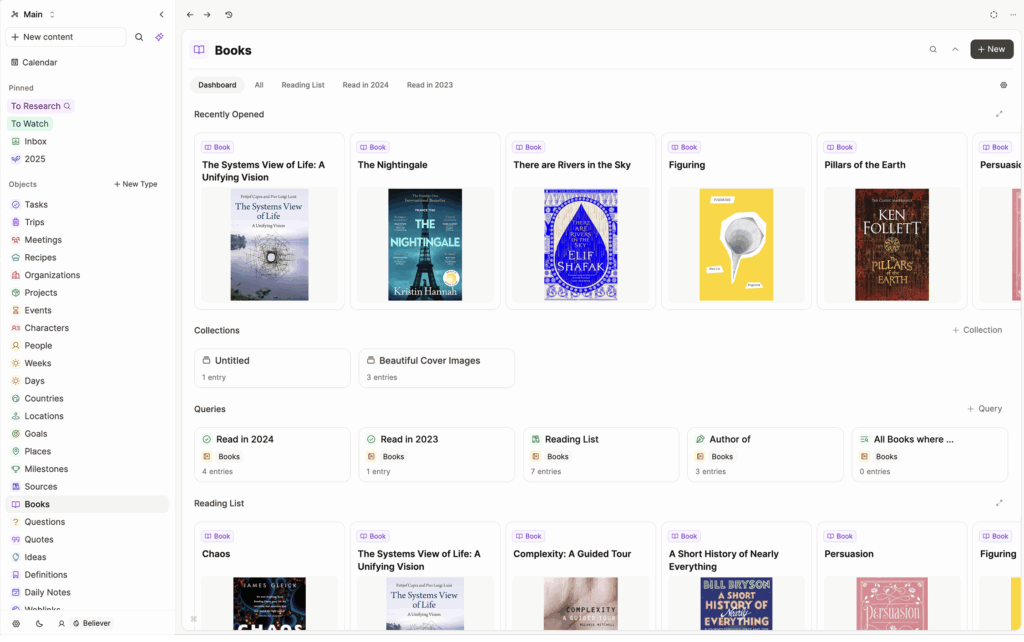
In Capacities, each object type has its own set of properties unique to it. In a file and folder structure, all your notes are flat documents. They don’t reflect the type of thing you are taking notes on. Object types and networked notes solve this problem.
You don’t have to think about organizing your notes or setting up an elaborate system around them. All you need to know is the type of note you’re taking (book or person), and start writing. Capacities will do the rest for you.
Imagine trying to create this connection in a file and folder structure. You’d have to create a book note, and then mention in that note somewhere that Julie recommended it to you.
Maintaining a file and folder approach to your knowledge work introduces an admin and organization overhead, and requires more clicking around. You have to remember where you put things, and where to put them in the first place. You’re adding mental load to your organizational system, which is stealing mental headspace from doing the actual work that matters to you.
Capacities also completely removes the decision making process around where to store notes, because often when you’re starting to take a note you don’t know what it is yet or where it belongs. In Capacities, you don’t have to think about it; you can just start writing. You can always easily change object types later, and notes can show up in multiple places at once through links.
Object types follow the natural way we think about things, which is as objects. You don’t have to remember where you put anything because the way you organized your thoughts mirrors exactly the way you think. You can trust that things will appear when they are contextually relevant in Capacities, and you won’t see them when you don’t need to.
You also never have to worry about being locked into a specific setup. We also make it super simple to change between object types, so if you change your mind about something, you don’t have to worry about reorganizing anything.
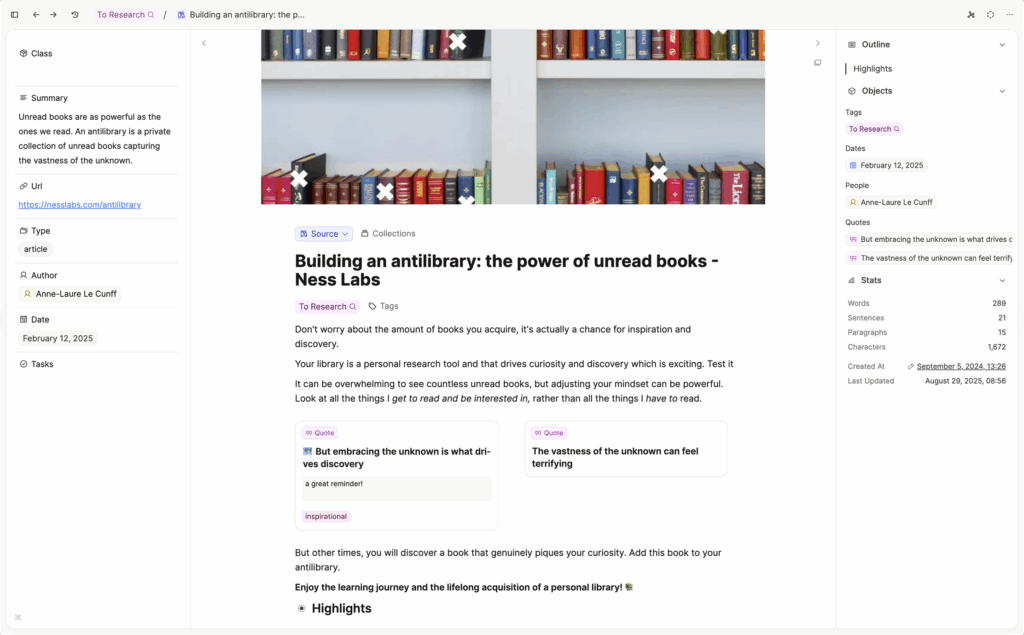
Amazing, now let’s go a bit deeper into how Capacities works.
Again, object types are central to how Capacities works. By creating objects (different types of notes) and connecting them to other objects when relevant, you can create a network of notes. You can think of this like building your own personal wiki of everything important to you.
The core functionality of Capacities is creating custom object types, taking notes in objects (book, film, article, meeting note, project, etc), and making connections between them. You can also choose separate page layouts for each object type so that your notes look the way you feel they should based on the object type.
You can also create templates to help automate your workflows in specific object types. Do you have a layout you reuse over and over again to structure your meeting agenda, or your book reflection notes? You can create templates that can automatically populate new objects, so you can get straight to writing.
The daily note sits at the heart of our functionality. You get a fresh daily note every day that you can use however you see fit; as a scratchpad for quick notes, for interstitial journaling, for planning your day.
But the magic starts to happen when you create new objects in Capacities. You’ll see these new objects appear under your daily note in the ‘created today’ section. Every note you make is linked to a date and time. This way, you can easily trace back your thoughts to pinpoint them to a specific date.
If you can’t remember when you took notes on something, or when you had that really good idea, you can easily click through and find your note tied to your daily note, or under the created today section. Time is a central pillar of our philosophy, and the daily note helps us weave our thoughts and ideas together and place them concretely in moments in time.
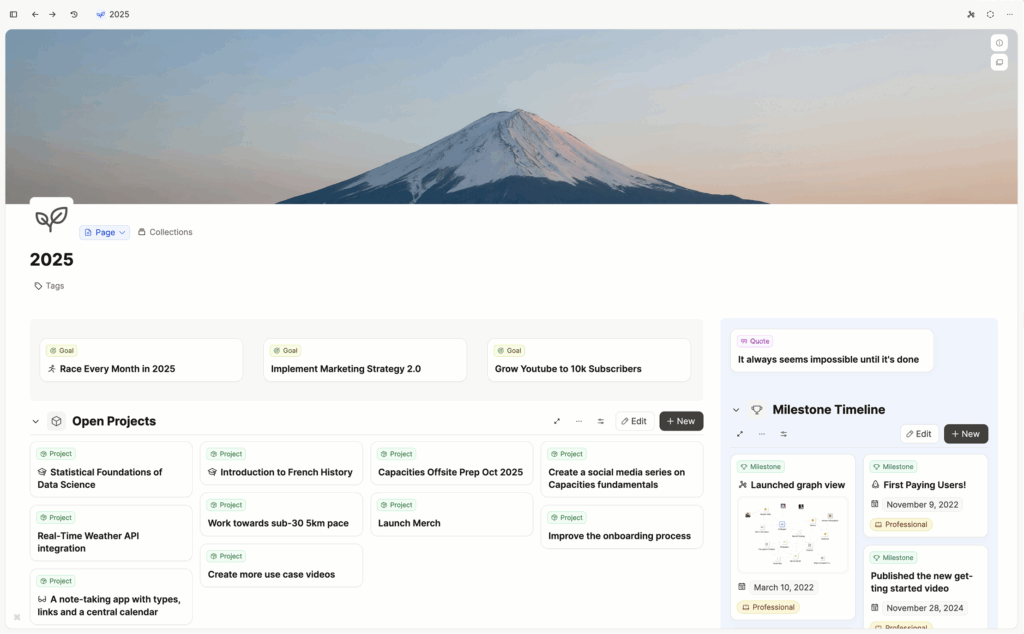
You mentioned that Capacities is not trying to be an all-in-one tool. What will it do, and what will it not do?
Capacities is definitely not an all-in-one tool, and we’re not trying to build one. We’re very intentional about the features we develop because we don’t want to add superfluous features that would bloat the app and dilute from our core mission.
One is collaborative features. Capacities is an app for individuals and we don’t want people to feel pulled in multiple directions by notifications or other people’s presence in their workspace. You can’t do your best thinking if you feel like you have to filter every thought or idea before they are fully developed. It’s a thinking tool for your brain, not for other people’s brains.
We designed Capacities to sit at the heart of your creative workflow, where you can make sense of things for yourself, before you take your best work to other people in whatever collaborative space makes sense to you.
We also don’t want Capacities to become a fully-fledged task or project management app. We do support light task management, and the app is great for conceptualizing and doing research around your most important projects. But Capacities won’t replace a dedicated task or project management system for people who need power features.
Acknowledging that, we’ve implemented an integration that lets you send tasks to your dedicated task management app with a keystroke right from within Capacities.
The same logic extends to our calendar integration. Capacities works well together with your calendar app, enabling you to view all your events right within the daily note, to take notes on calendar events and to create new events from notes. But it could never fully replace your calendar app.
One of the integrations our users love the most is our Whatsapp integration: you can text your Capacities space from Whatsapp, and your text will appear in your daily note! This makes it super easy to get notes down into your space no matter where you are.
Our approach to integrations reflects our philosophy of simple and intuitive design. We want the app to just work for most users.
This is also the reason we are not offering a plugin architecture. We want the experience to be seamless and work out of the box without the need to tinker around to create the perfect setup. Plugins also tend to have issues with maintenance and support that requires users to constantly pay attention and reevaluate their setup.
What kind of people are drawn to Capacities, and how do they use it?
Capacities attracts people who are deeply engaged with their work but often feel overwhelmed by all the noise and complexity around them. Our users are researchers, students, founders, writers, and developers—people who want to focus on what really matters without spending hours setting things up or maintaining their system. That’s exactly what Capacities helps them do.
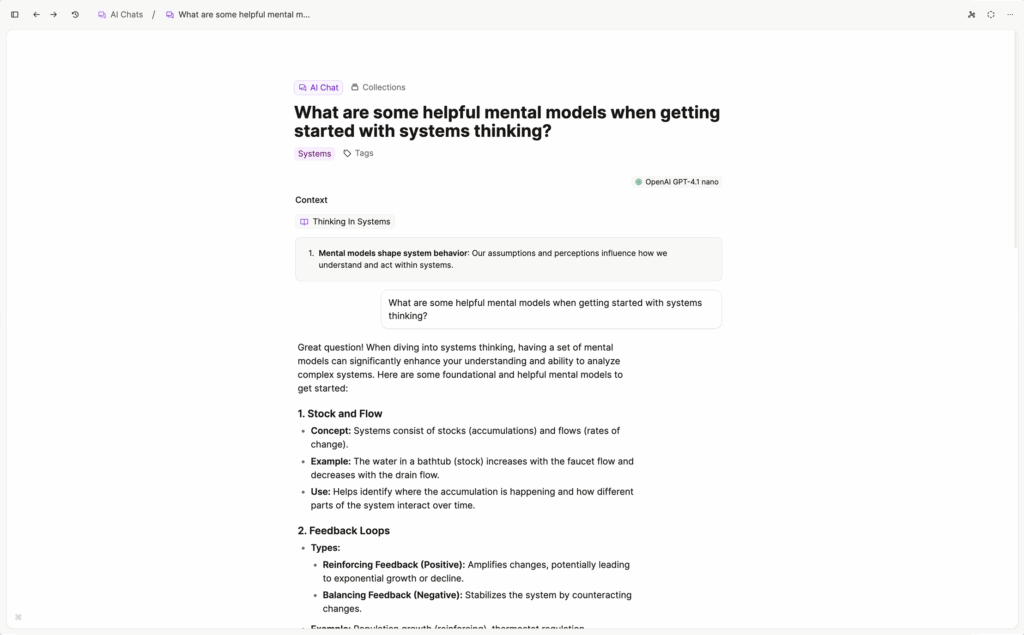
We’ve heard from many people with ADHD who say the app has completely changed how they take notes. The graph view, for example, feels natural to them—it mirrors the way their brains make connections between ideas. They love that they can finally stop worrying about keeping everything organized because the app does that part for them.
Others tell us that their entire workflow has clicked into place since they started using object types in Capacities. Once they got the hang of it, things just started to flow more naturally. They’ve noticed a big boost in focus and attention to detail, because the system now fits the way they think, not the other way around.
And one thing we’re especially proud of is how little setup Capacities needs. You make a few key decisions once, and then you can just use it. Even our own team members, who’ve been using it for years, rarely change their setup. That’s by design.
While plugins and endless customization can be fun at first, they often turn into tinkering instead of creating. Our users are passionate about their work, and we want to help them get straight to it—with as little friction as possible.
What about you, how do you use Capacities?
We both use Capacities in our daily lives in both personal and work contexts. Often it is hard to separate the two, but Capacities helps us create mental space and peace of mind.
Steffen: I know, I have to say this, but I honestly don’t know how I’d work without Capacities. It became a) my daily driver and b) my repository of thoughts and ideas, and a place to think. I use it every day for my tasks. I’m not a big fan of complicated task management. I use a linear list of To-Dos and projects to group my To-Dos.
However, I mainly use Capacities to process the books I read, jot down inspiring thoughts, and connect them with topics, projects and atomic notes. I track meetings and sessions and write down thoughts on everything I do in my daily notes.
Because I have been doing this consistently for a few years now, I have a very powerful idea network at my fingertips that I can browse. It allows me to jump into a thought train I had half a year ago, helps me make better hiring decisions, develop more consistent and thought-through arguments for the next blog article I write, or gives me an overview of all the ideas that went into a project before I’m defining the actual tasks for the team. For me, Capacities is about fun, curiosity, peace of mind, and clear thinking. I genuinely love it.
Michael: Capacities really is my daily companion—it’s open pretty much all day and quietly supports everything I do.
My day usually starts with some reading and writing as part of my morning routine, plus some light habit tracking. Capacities makes it easy to keep a reading journal, which has become a big part of how I process what I read. And with our new Readwise integration (currently in beta), that’s gotten even smoother.
When I’m ready to get into work mode, I plan my day using the daily note and a simple page where I keep my current tasks and to-dos. Nothing fancy, just what I need to stay focused.
Throughout the day, I’ll dip in and out of Capacities to capture ideas, think things through, or plan upcoming projects. Then in the evening, I like to log my workouts and jot down a few reflections about the day.
It might sound like a lot, but it never feels like busywork. I rarely have to stop and “organize” anything—it just flows naturally. The system adapts to my day rather than the other way around, which is exactly how I want it to be.
And finally… Looking ahead, what’s next for Capacities?
Our long-term goal is to develop more humane software to empower our users to do their best thinking. We should be bolstered by the tools we use, not hindered by them. We’re always working on making Capacities as intuitive as possible.
One of our overall goals is to help users make more intentional decisions across their day-to-day lives when it comes to consuming information. Maybe over time, after developing a note-taking practice, they will reach for Capacities as a quiet respite instead of doomscrolling on social media.
We are firm believers that by taking notes and engaging with your curiosities and the world around you, you can discover the things you’re truly passionate about and start engaging more deeply with things that bring you joy.
This can feel like a lofty statement from a note-taking app, but we truly believe that note-taking, which is in essence just paying attention and writing things down, can help you do this. We want to help our users live more intentional lives, whatever that looks like for them.
Thank you so much for your time, Steffen and Michael! Where can people learn more about Capacities?
Of course! You can visit our website to download our desktop app, and you can also find us across socials on YouTube, LinkedIn, and Instagram.
The post Building a studio for your mind: an interview with the founders of Capacities appeared first on Ness Labs.
2025-09-03 16:38:00
Last week, I found myself explaining the Burning Man tradition of “tutu tuesday” to my Algerian mother, then an hour later debating theories of consciousness with a fellow nerd on the internet. I wasn’t just switching languages – I was switching entire ways of thinking. And I was doing it without realizing it.
Most people think multiculturalism means passport stamps and foreign languages. But there’s a more powerful kind happening right in your head: cognitive multiculturalism: the mental flexibility and fluency you develop from experiencing different worlds.
Not different countries necessarily, but different neighborhoods, friend groups, books, jobs, or communities. It’s what happens when you’ve navigated a wide enough variety of contexts that your brain gets good at switching between ways of thinking depending on the situation.
When you’ve been exposed to different contexts, situations and perspectives, your mind develops multiple models and learns to pick the right one for the situation.
Your brain is essentially learning different codes for thinking and progressively becoming fluent enough to switch between them automatically.
For instance, people with diverse social networks develop better perspective-taking abilities. They become skilled at reading how others think and feel across different contexts.
You probably notice something similar when you consume different types of content. Think about how you adjust when switching between a philosophy book and a comedy podcast, or between watching a documentary and reading fiction.
Each requires you to adapt to different conventions and ways of understanding the world.
Studies also find that people who belong to lots of different groups and consider they have many identities are less prejudiced and more mentally flexible (which psychologists call “social identity complexity”).
When you see yourself as many things at once – whether that’s your profession, your neighborhood, your hobbies, your generation – you become more nuanced and flexible as a person.
And this kind of cognitive multiculturalism translates into real creative advantages. People with multicultural experiences are better at insight problems, making unexpected connections, and generating new ideas. Different experiences expand how you view the world, making it easier to combine ideas in new ways. So, how can you nurture your cognitive multiculturalism?
Cognitive multiculturalism gives you the mental agility to better navigate workplace dynamics, understand global events, or simply connect with people different from yourself. And you don’t need to move abroad or learn a new language. You just need to intentionally diversify three things:

1. Your inputs. That includes books, media, and ideas. Don’t just stick to your comfort zone. Read authors from different eras, geographies, or disciplines. Choose media that challenges your assumptions rather than confirms them. Each new way of thinking you encounter expands your cognitive map.
2. Your people. Expand and mix up your social circles by seeking out relationships across generations, professions, and backgrounds. Each person will offer a different mental model of the world, and exposure to these models will diversify your own.
3. Your identities. Don’t limit yourself to one role. Try on different versions of yourself. Experiment with taking up hobbies, joining new communities, or working in unfamiliar environments. Notice how your behavior shifts, and use that metacognitive awareness to expand your sense of self.
Most of us already cross more borders than we notice. We move between work and home, different groups of friends, different media diets. Just pay attention to those borders and push them a little further. That’s what cognitive multiculturalism really is: being deliberate about the diversity of experiences that shape how you think.
The post Cognitive Multiculturalism: Training Your Brain to Switch Between Worlds appeared first on Ness Labs.